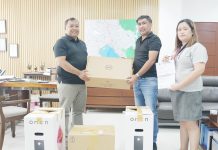TACLOBAN CITY — Concerns have been raised over early signs of environmental degradation in Cuatro Islas, an emerging tourist destination in Leyte province.
In a “Protect Cuatro Islas” report issued Tuesday, the Department of Environment and Natural Resources (DENR) regional office here said the environmental condition of the four picturesque small islands is not as worse as Boracay’s but early signs of pollution are now evident.
These four islands are Apid, Mahaba, and Digyo in Inopacan town; and Himokilan in Hindang town.
The 48-hectare Himokilan Island is the most populated with 200 families or 1,110 individuals.
There are about 2,138 people living on the four islands, which were declared as marine protected areas by virtue of Presidential Proclamation No. 270 dated April 13, 2000.
Among the environmental issues identified by the DENR include the existence of communities in the protected landscape, biodiversity disturbance due to influx of tourists, and poor waste management.
“As small islands, these are not capable to withstand the pressure of communities in the area. Adding pressures to the fragile ecosystem is the influx of tourists,” said DENR regional information officer Maita Reina Sucgang.
Sucgang said the island’s carrying capacity has been breached since early 2015 after the local governments of Hindang and Inopacan intensified promotion their tourism activities.
The DENR assessment team noted that many families on the four islands are non-tenured migrants, with some of them already served notices to demolish structures that disturbed the natural biodiversity and vegetation.
“Solid waste generation in disposal in Digyo Island alone is basically increasing due to high influx of the coming in and out of visitors and tourists contributing to number of kilograms of garbage per person per day. However, only 30 percent of these were then regularly collected by the local government and brought out of the four islands in compliance to the protected area rules,” the report said.
Earlier, the DENR launched “Protect Cuatro Islas” campaign in its bid to raise awareness and understanding on the significance of cleaning up not as an ecotourism area, but also as an ecosystem.
The drive also seeks to elicit support and participation of stakeholders in saving the eco-tourism destination, and strengthen partnerships and networks for this effort.
Cuatro Islas covers an area of 12,500 hectares known for its white sandy shores surrounded by coral gardens, which are considered as one of the best in Leyte Island. It is home to Tridachna and marine turtles such as Green Sea and Hawk bill turtle.
Experts found 287 species of reef building corals in the island’s waters. It is also a rich fishing ground and a home to countless diverse coastal and marine organisms, wildlife and ecosystems. (SARWELL Q. MENIANO/PNA)



